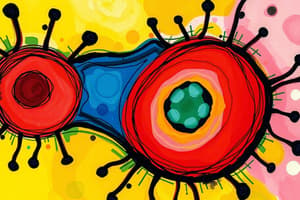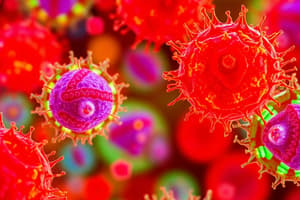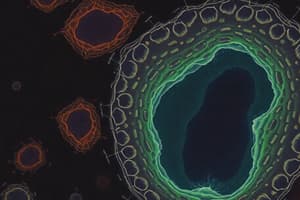Podcast
Questions and Answers
Which structure serves as a selective barrier in cells?
Which structure serves as a selective barrier in cells?
- Nucleus
- Cytoplasm
- Plasma membrane (correct)
- Golgi apparatus
What is a defining characteristic of prokaryotic cells?
What is a defining characteristic of prokaryotic cells?
- Larger and more complex structure
- Lack of membrane-bound organelles (correct)
- Contain multiple chromosomes
- Presence of a nucleus
What role do ribosomes play in the cell?
What role do ribosomes play in the cell?
- Store nutrients
- Produce ATP
- Digest waste materials
- Synthesize proteins (correct)
Which organelle is primarily involved in energy production?
Which organelle is primarily involved in energy production?
What process involves the movement of water across a selectively permeable membrane?
What process involves the movement of water across a selectively permeable membrane?
What type of transport requires energy input?
What type of transport requires energy input?
Which organelle is responsible for sorting and packaging proteins?
Which organelle is responsible for sorting and packaging proteins?
What structure provides structural support and facilitates cell movement?
What structure provides structural support and facilitates cell movement?
What does tonicity refer to?
What does tonicity refer to?
What occurs in a hypotonic solution?
What occurs in a hypotonic solution?
Which condition correctly describes a hypertonic solution?
Which condition correctly describes a hypertonic solution?
Which factor does not affect the rate of diffusion?
Which factor does not affect the rate of diffusion?
What is the net movement of molecules during diffusion?
What is the net movement of molecules during diffusion?
Flashcards
Prokaryotic Cell
Prokaryotic Cell
A single-celled organism without a nucleus or membrane-bound organelles.
Eukaryotic Cell
Eukaryotic Cell
A complex cell with a nucleus and membrane-bound organelles.
Plasma Membrane
Plasma Membrane
The outer boundary of a cell, controlling what enters and leaves.
Passive Transport
Passive Transport
Signup and view all the flashcards
Diffusion
Diffusion
Signup and view all the flashcards
Active Transport
Active Transport
Signup and view all the flashcards
Osmosis
Osmosis
Signup and view all the flashcards
Nucleus
Nucleus
Signup and view all the flashcards
Tonicity
Tonicity
Signup and view all the flashcards
Isotonic Solution
Isotonic Solution
Signup and view all the flashcards
Hypotonic Solution
Hypotonic Solution
Signup and view all the flashcards
Hypertonic Solution
Hypertonic Solution
Signup and view all the flashcards
Study Notes
Cell Structure and Function
- Cells are the basic units of life, exhibiting diverse shapes and sizes tailored to their specific roles.
- All cells share fundamental components: a plasma membrane, cytoplasm, and genetic material.
- The plasma membrane acts as a selective barrier, controlling the passage of substances into and out of the cell.
Prokaryotic Cells
- Lack a nucleus and membrane-bound organelles.
- Typically smaller and simpler than eukaryotic cells.
- Examples include bacteria and archaea.
- Contain DNA in a region called the nucleoid.
- May possess cell walls, flagella, and pili.
Eukaryotic Cells
- Possess a nucleus and membrane-bound organelles.
- More complex and larger than prokaryotic cells.
- Examples include animal, plant, fungi, and protist cells.
- Nucleus houses the cell's genetic material (DNA).
- Organelles perform specialized functions, contributing to cellular activities.
Key Cell Organelles and Their Functions
- Nucleus: Contains DNA, regulating cellular activities.
- Ribosomes: Synthesize proteins.
- Endoplasmic Reticulum (ER): Rough ER is involved in protein synthesis and modification; smooth ER is involved in lipid synthesis and detoxification.
- Golgi apparatus: Processes, packages, and sorts proteins and lipids.
- Mitochondria: Produce ATP (energy) through cellular respiration.
- Lysosomes: Contain enzymes for intracellular digestion.
- Vacuoles: Store water, nutrients, and waste products.
- Chloroplasts (plant cells): Conduct photosynthesis.
- Cytoskeleton: Provides structural support and facilitates cellular movement.
Cellular Transport
-
Passive Transport: Movement of molecules down a concentration gradient, requiring no energy input.
- Diffusion: Movement of molecules from high to low concentration.
- Osmosis: Diffusion of water across a selectively permeable membrane.
- Facilitated Diffusion: Diffusion of molecules across a membrane with the aid of transport proteins.
-
Active Transport: Movement of molecules against a concentration gradient, requiring energy input (ATP).
- Sodium-Potassium Pump: A crucial example of active transport maintaining ion gradients.
Osmosis
- The movement of water across a selectively permeable membrane from a region of high water concentration to a region of low water concentration.
- Crucial for maintaining cell volume and function.
- Tonicity: Refers to the relative solute concentrations of two solutions separated by a selectively permeable membrane.
- Isotonic Solutions: Solute concentration is equal inside and outside the cell.
- Hypotonic Solutions: Solute concentration is lower outside the cell. Water moves into the cell, causing swelling or lysis.
- Hypertonic Solutions: Solute concentration is higher outside the cell. Water moves out of the cell, causing shrinkage or crenation.
Diffusion
- The net movement of molecules from an area of high concentration to an area of low concentration.
- Factors influencing diffusion rate include:
- Concentration gradient
- Temperature
- Molecular size
- Membrane permeability
- Essential for diverse cellular processes, including nutrient uptake and waste removal.
Studying That Suits You
Use AI to generate personalized quizzes and flashcards to suit your learning preferences.




